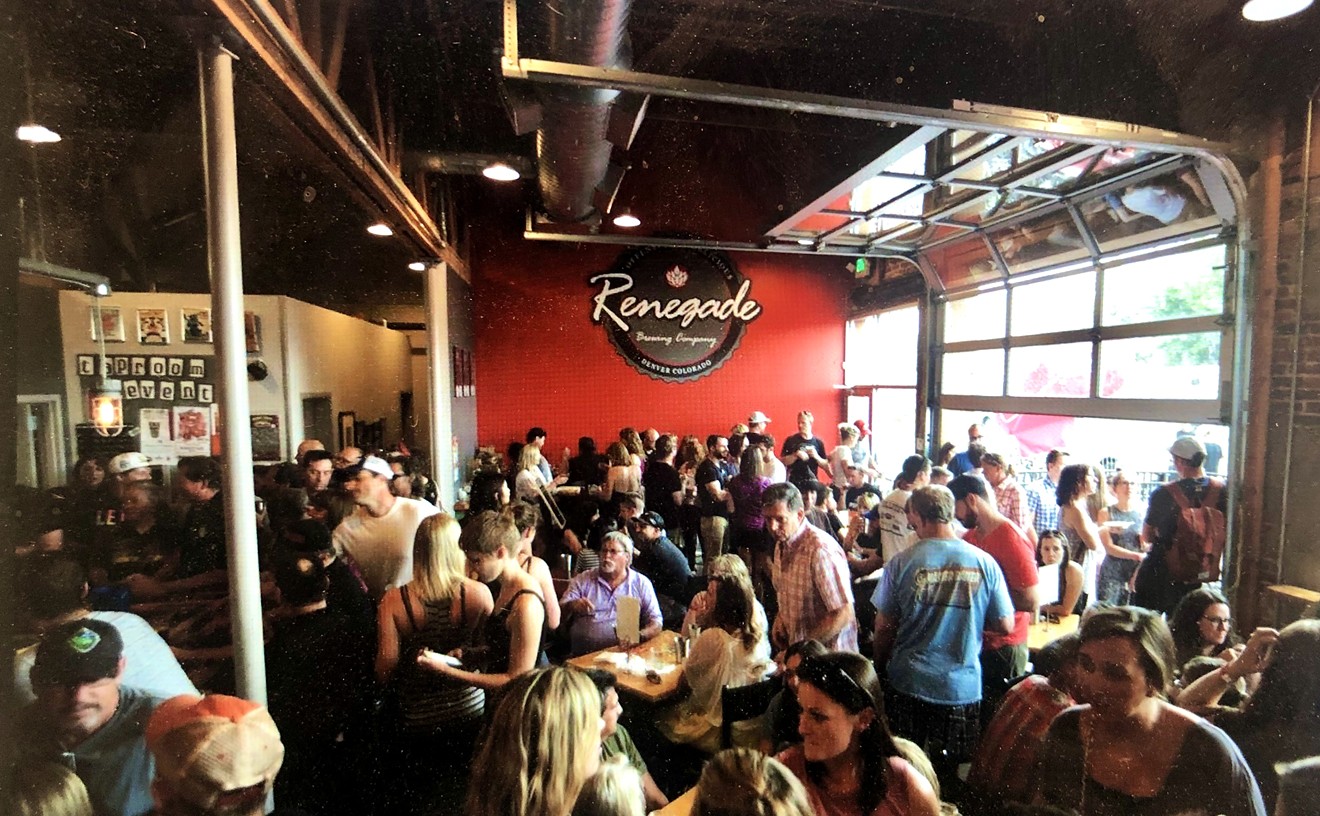And that's fine, if you like eating little bits of food and then forking over large amounts of money. But on my visits to Denver's oh-so-trendy tapas places, I've found that while most diners love the idea of tapas, the romance ends quickly when they see that the bill is even bigger than the space left in their stomachs. Which means, of course, that this latest dining fad could do a fast fade.
Like the legend of Caesar salad and the tale of Melba toast, the story of how tapas got started is very much subject to speculation, bad historical records and pure fabrication, much of it springing from the meaning of tapa, the Spanish word for "lid" or "top." There's the theory about a turn-of-the-century men's club that met in a building across from a bar, whose members sent boys over to buy drinks whenever they wanted to whet their whistles; the bartenders, not wanting the drinks to spill out of the glasses or detritus to fall into them, put rounds of ham or cheese over the tops. A variation on this theme is the notion that tapas were invented by Spanish fishermen who put lids of ham or cheese over their drinks so the liquids wouldn't slosh out when the boats hit choppy water. And then there's the historical approach, which argues that the Moorish occupation of southern Spain for 700 years allowed ample time for the introduction of mezzes, Middle Eastern snacks similar to tapas.
Whatever theory you buy into, in modern-day Spain tapas are "small foods" served in tascas, little bars where people gather to sip sherry and suck down a few fresh sardines, cold Spanish omelettes (nothing like the imposter found on breakfast menus in this country) or snails in a spicy sauce. Some of the bars are set up like kiosks in the middle of a mall, where customers simply stand outside, munching and drinking glasses of sangria. Others set out their tapas offerings along the bar itself (beware the mayonnaisey items, which are popular in Spain despite that country's lack of refrigeration), and patrons seated on bar stools just point to whatever strikes their fancy. Some places charge by the item, while others charge one price for a sampler of several tapas--either way, you never wind up paying an arm and a leg for a wing. Or, in the case of Denver's Tapas, three chicken drumettes.
The restaurant is part of the triumvirate that Francois Safieddine--owner of the Purple Martini--has installed in the LoDo building that once housed Al Fresco. Each of the storefront's three floors features a different concept: below ground level sits Beluga, a members-only caviar bar; above it resides Tapas; and on the top floor is Club Velvet, a nightclub filled with leopard spots and exposed brick. Tapas sports an equally trendy look, "industrial chic" accented with blond woods and surprisingly comfortable art-deco benches softened by large pillows.
Tapas's chef is Zouhair Ait-Naceur, who reportedly grew up in Spanish Morocco and is responsible for the menu's northern Italian/ Mediterranean bent. And, despite the restaurant's name, that menu isn't limited to tapas: At lunch there are also pizzas, salads, pastas and panini; at dinner, pizzas, pastas, meat and fish dishes and paellas.
But it's the tapas that get top billing here. Too bad they don't deserve it.
Our first Tapas tapa was the disappointing pollo chilindrón ($5.50): three dried-out, obviously-cooked-at-least-a-day-before chicken drumettes. I spotted just three tiny squares of serrano ham and couldn't detect any saffron at all; the sauce the chicken had been braised with tasted primarily of sweet bell pepper with a hint of onion. Any braising, however, had been done long before these little drumette boys were microwaved for us, and the juices had evaporated, leaving the chicken shriveled and dry.
The gambas al ajillo ($6.50), on the other hand, had plenty of liquid: Three water-retaining, dull tiger shrimp were awash in a red chile-infused sherry that carried none of the promised garlic. Also all wet were the champinones a la parilla ($6.50), and not just because the plural portabellos turned out to be just one 'shroom (and a small one at that). The lonely portabello had been sliced and smashed against limp mixed greens in a nebulous, watery vinaigrette; next to the mushroom shreds sat a timbale of risotto, so dry it had a crust.
Those starters were easily topped by the esparagos al pinole ($5.25), chilled, still-crunchy asparagus spears marinated in a red-pepper vinaigrette that had a nice bite. And our luck held with the guinillas ($4.75), roasted green and red peppers marinated in something that tasted like olive oil and served with Manchego cheese, a ewe's-milk variety that's firm when it's three or four months old and more like parmigiano-reggiano when it's older. This was the younger version, and it was excellent. So we had high hopes for the quesos de cabra ($5.50), but this tapa didn't quite live up to its description. There was one gumball of well-aged goat cheese, one flat round of goat, a blue that seemed more like ewe than goat, and a slice of the non-goat Manchego. As for the promised seasonal fruits, they consisted of three skinny apple slices and four grapes.
We could have ended the meal there and called things about even. Instead, I asked for two pizzas to go. The dry, cardboardy crust of the pizza con prosciutto ($6.75) held so little fresh tomatoes, mozzarella and Parma ham that I thought the toppings must have slid off into the box (they hadn't). And while the pizza madrelina ($5.75) held on to its few bits of chorizo, chicken chunks and Manchego cheese, the combination was blah.
On a second visit, I continued working my way through the tapas selections. The pinchos morunos ($5.50) offers a choice of lamb, beef or pork on a "prochette," according to the menu--by which it really means a brochette of meat that's skewered and grilled. We went with the lamb, which was so succulent we wished we'd gotten more than just two stingy chunks of meat. There were plenty of clams in the almejas al vapor ($6.75), but the insipid broth, which was supposedly flavored with shallots, tomatoes and white wine, tasted of nothing but white wine.
The broth in the sopa del dia ($4) was even blander. Our waitress had described the soup of the day as "chicken soup with rice and mushrooms in a light broth"; this broth was so light it had all the flavor of water. It also held plenty of tender chicken and strong mushrooms but not a grain of rice. Our Caesar salad ($5) was lacking, too--in anchovy, Worcestershire and garlic--but had more than enough mayo-ey dressing and good croutons.
When I returned a third time, I finally got to try the tortilla espanola ($5.75), the quintessential tapa that's supposed to be a cold Spanish omelette of sliced potatoes, onions and eggs. But at Tapas, the kitchen apparently is making the tortilla too close to serving time, because the one I got was lukewarm. The temperature detracted from the perfectly cooked-through tubers, although the tortilla came with the added bonus of romesco, a Spanish sauce of tomatoes, onions, garlic, almonds and olive oil.
One of our entrees, the pan-seared filet mignon with Andalusian sauce (a fancy way of saying tomato) and garlic mashed potatoes ($19.50), was small enough to be a tapa, despite the hefty price tag. The meat was fine, though, even if the spuds were way too garlicky. Portion wasn't the problem with the baked salmon ($14.75): Overdone and dry in the center, the fish was coated with a sickeningly sweet sauce of caramelized onions, raisins, red chiles and cognac.
But our third try was a charm. Unlike most places that attempt the dish, Tapas offers paella for one, and I, for one, appreciated the paella Valenciana ($14.75). This was a first-rate rendition, a mix of saffron-immersed rice, shrimp, mussels, clams, calamari and chicken. But the key ingredient was Tapas's superior chorizo, based on the Spanish smoked-pork model (rather than the Mexican fresh-pork version), redolent with garlic and chiles, so smoky and deep-flavored that its pungency permeated everything.
This dish so topped the tapas that Safieddine should consider changing the name of his place to Paella. After all, unlike flash-in-the-pan fads, good taste--and good-tasting food--never goes out of style.
Tapas, 1523 Market Street, 607-9209. Hours: 11 a.m.-3 p.m., 5-11 p.m. Monday-Thursday; 11 a.m.-3 p.m., 4 p.m.-1 a.m. Friday; 4 p.m.-1 a.m. Saturday; 5-11 p.m. Sunday.










